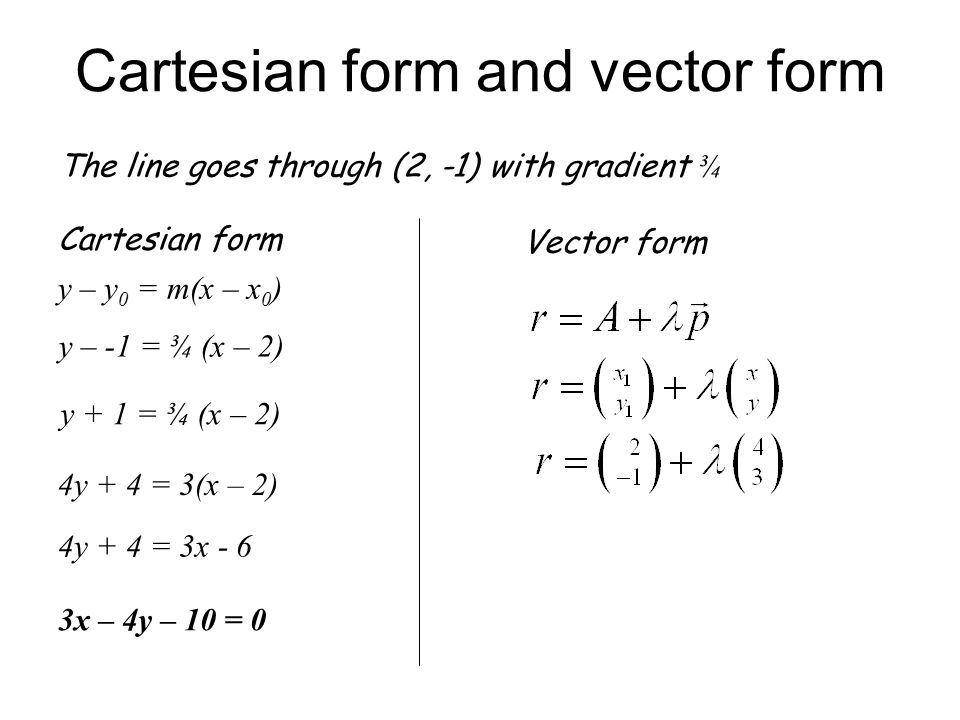Line Vector Form
Line Vector Form - P.14 the point on this line which is closest to (x0, y0) has coordinates: Web the line’s vector equation is represented by its general form shown below. Vector form of the equation of a line in two dimensions. R → = a → + λ b →, where λ is scalar. The line with gradient m and intercept c has equation. T = x + 1 −2 t = y − 1 3 t = z − 2 t = x + 1 − 2 t = y − 1 3 t = z − 2 so you have: The two given equations represent planes, and the required line is their intersection. The vector equation of a line passing through a point and having a position vector →a a →, and parallel to a vector line →b b → is →r = →a +λ→b r → = a → + λ b →. It is obvious (i think) that the line is parallel to the cross product vector u × v u. Then, is the collection of points which have the position vector given by where.
You're already familiar with the idea of the equation of a line in two dimensions: Web 1 the vector form is given simply rewriting the three equations in vector form: If i have helped you then please support my work on patreon: For each $t_0$, $\vec{r}(t_0)$ is a vector starting at the origin whose endpoint is on the desired line. Web one of the main confusions in writing a line in vector form is to determine what $\vec{r}(t)=\vec{r}+t\vec{v}$ actually is and how it describes a line. Web the two methods of forming a vector form of the equation of a line are as follows. Then is the direction vector for and the vector equation for is given by Each point on the line has a different value of z. \lambda λ below is a parameter. Vector equation of a line suppose a line in contains the two different points and.
The position vector →r for a point between p and q is given by →r = →p + →v You're already familiar with the idea of the equation of a line in two dimensions: No need to get in line to start using them! (we could just as well use x or y.) there is no law that requires us to use the parameter name t, but that's what we have done so far, so set t = z. A second way to specify a line in two dimensions is to give one point ( x 0, y 0) on the line and one vector n = n x, n y whose direction is perpendicular to that of the line. The two given equations represent planes, and the required line is their intersection. [3] horizontal and vertical lines T = x + 1 −2 t = y − 1 3 t = z − 2 t = x + 1 − 2 t = y − 1 3 t = z − 2 so you have: Vector equation of a line suppose a line in contains the two different points and. For each $t_0$, $\vec{r}(t_0)$ is a vector starting at the origin whose endpoint is on the desired line.
Line seamless pattern 557703 Vector Art at Vecteezy
(we could just as well use x or y.) there is no law that requires us to use the parameter name t, but that's what we have done so far, so set t = z. Web 1 the vector form is given simply rewriting the three equations in vector form: If 𝐴 ( 𝑥, 𝑦) and 𝐵 ( 𝑥, 𝑦).
General Form Equation Of A Line Tessshebaylo
We'll use z as the parameter. You're already familiar with the idea of the equation of a line in two dimensions: They're scalable, modifiable, adaptable and, most importantly, downloadable. This vector is not, in general, a vector that ''lies'' on the line, unless the line passes through the origin (that is the common starting point of all vectors). Web vector.
Vector Line Png ClipArt Best
Then, is the collection of points which have the position vector given by where. R → = a → + λ b →, where λ is scalar. I'm proud to offer all of my tutorials for free. T = x + 1 −2 t = y − 1 3 t = z − 2 t = x + 1 −.
Ex 11.2, 5 Find equation of line in vector, cartesian form
Where u = (1, 1, −1) u = ( 1, 1, − 1) and v = (2, 2, 1) v = ( 2, 2, 1) are vectors that are normal to the two planes. T = x + 1 −2 t = y − 1 3 t = z − 2 t = x + 1 − 2 t =.
Vector Equation of a Line YouTube
For each $t_0$, $\vec{r}(t_0)$ is a vector starting at the origin whose endpoint is on the desired line. Let and be the position vectors of these two points, respectively. T = x + 1 −2 t = y − 1 3 t = z − 2 t = x + 1 − 2 t = y − 1 3 t.
Lesson Video Equation of a Straight Line Vector Form Nagwa
No need to get in line to start using them! When we try to specify a line in three dimensions (or in n dimensions), however, things get more involved. The vector equation of a line passing through a point and having a position vector →a a →, and parallel to a vector line →b b → is →r = →a.
Question Video Finding the Vector Form of the Equation of a Straight
Web the two methods of forming a vector form of the equation of a line are as follows. R = r o + t v, where r o represents the initial position of the line, v is the vector indicating the direction of the line, and t is the parameter defining v ’s direction. For each $t_0$, $\vec{r}(t_0)$ is a.
5. Example of Vector Form of a Line YouTube
Each point on the line has a different value of z. Web the two methods of forming a vector form of the equation of a line are as follows. Web equation of a line in vector form. ⎡⎣⎢x y z⎤⎦⎥ =⎡⎣⎢−1 1 2 ⎤⎦⎥ + t⎡⎣⎢−2 3 1 ⎤⎦⎥ [ x y z] = [ − 1 1 2] +.
Vector Form at Collection of Vector Form free for
Web equation of a line: R → = a → + λ b →, where λ is scalar. Let and be the position vectors of these two points, respectively. Note as well that while these forms can also be useful for lines in two dimensional space. Web adding vectors algebraically & graphically.
Vector Equation Line & Plane Equations, Formula, Examples
We'll use z as the parameter. We will also give the symmetric equations of lines in three dimensional space. Web x − x 0 d x = y − y 0 d y. (we could just as well use x or y.) there is no law that requires us to use the parameter name t, but that's what we have.
Web Adding Vectors Algebraically & Graphically.
(we could just as well use x or y.) there is no law that requires us to use the parameter name t, but that's what we have done so far, so set t = z. Magnitude & direction to component. No need to get in line to start using them! We'll use z as the parameter.
Web To Find The Position Vector, →R, For Any Point Along A Line, We Can Add The Position Vector Of A Point On The Line Which We Already Know And Add To That A Vector, →V, That Lies On The Line As Shown In The Diagram Below.
Web write the equation of the line in general form, vector form, or parametric form. A second way to specify a line in two dimensions is to give one point ( x 0, y 0) on the line and one vector n = n x, n y whose direction is perpendicular to that of the line. This vector is not, in general, a vector that ''lies'' on the line, unless the line passes through the origin (that is the common starting point of all vectors). The position vector →r for a point between p and q is given by →r = →p + →v
\Lambda Λ Below Is A Parameter.
It is obvious (i think) that the line is parallel to the cross product vector u × v u. When we try to specify a line in three dimensions (or in n dimensions), however, things get more involved. If 𝐴 ( 𝑥, 𝑦) and 𝐵 ( 𝑥, 𝑦) are distinct points on a line, then one vector form of the equation of the line through 𝐴 and 𝐵 is given by ⃑ 𝑟 = ( 𝑥, 𝑦) + 𝑡 ( 𝑥 − 𝑥, 𝑦 − 𝑦). We will also give the symmetric equations of lines in three dimensional space.
Line Passing Through A Given Point And Parallel To A Given Vector Consider A Line Which Passes Through A Point With Position Vector A ⃗ \Vec{A} A A, With, Vector, On Top And Is Parallel To The Vector D ⃗.
In the above equation r →. Web equation of a line in vector form. Web equation of a line: The vector equation of a straight line passing through a fixed point with position vector a → and parallel to a given vector b → is.









